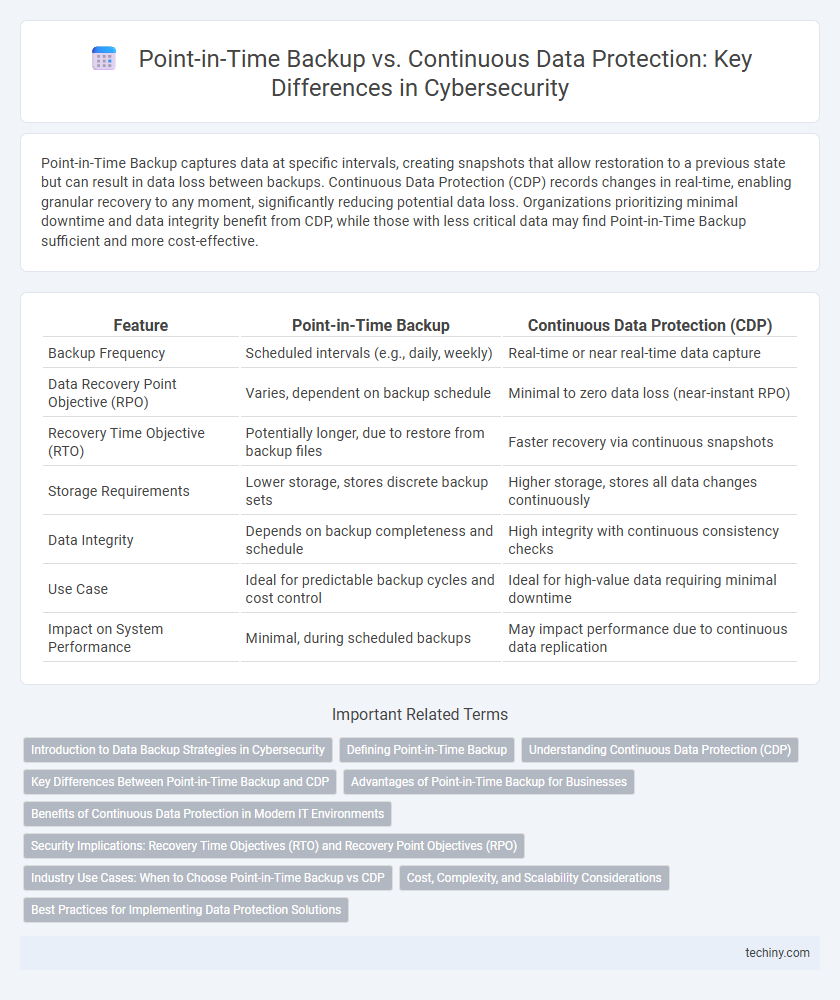Point-in-Time Backup captures data at specific intervals, creating snapshots that allow restoration to a previous state but can result in data loss between backups. Continuous Data Protection (CDP) records changes in real-time, enabling granular recovery to any moment, significantly reducing potential data loss. Organizations prioritizing minimal downtime and data integrity benefit from CDP, while those with less critical data may find Point-in-Time Backup sufficient and more cost-effective.
Table of Comparison
| Feature | Point-in-Time Backup | Continuous Data Protection (CDP) |
|---|---|---|
| Backup Frequency | Scheduled intervals (e.g., daily, weekly) | Real-time or near real-time data capture |
| Data Recovery Point Objective (RPO) | Varies, dependent on backup schedule | Minimal to zero data loss (near-instant RPO) |
| Recovery Time Objective (RTO) | Potentially longer, due to restore from backup files | Faster recovery via continuous snapshots |
| Storage Requirements | Lower storage, stores discrete backup sets | Higher storage, stores all data changes continuously |
| Data Integrity | Depends on backup completeness and schedule | High integrity with continuous consistency checks |
| Use Case | Ideal for predictable backup cycles and cost control | Ideal for high-value data requiring minimal downtime |
| Impact on System Performance | Minimal, during scheduled backups | May impact performance due to continuous data replication |
Introduction to Data Backup Strategies in Cybersecurity
Point-in-Time Backup captures data at specific intervals, creating snapshots that allow restoration to defined moments, which is essential for recovering from ransomware attacks or accidental deletions. Continuous Data Protection (CDP) records changes in real-time, enabling near-instant recovery and minimizing data loss by maintaining a constant backup stream. Both strategies are critical in cybersecurity for ensuring data integrity, reducing downtime, and supporting comprehensive disaster recovery plans.
Defining Point-in-Time Backup
Point-in-time backup captures data snapshots at specific intervals, enabling recovery to exact moments before data loss or corruption occurs. This method stores data versions at predetermined times, ensuring restoration to a known, stable state but potentially missing changes made between backups. Point-in-time backups provide reliable protection for critical systems by preserving consistent and recoverable data points in cybersecurity defense strategies.
Understanding Continuous Data Protection (CDP)
Continuous Data Protection (CDP) captures and saves every change made to data in real-time, reducing the risk of data loss by enabling recovery to any point within the protection window. Unlike point-in-time backup, which creates snapshots at scheduled intervals, CDP ensures near-instantaneous recovery and minimal data gaps after cybersecurity incidents. This granularity and immediacy make CDP a critical component in robust cyber defense strategies, especially against ransomware and advanced persistent threats.
Key Differences Between Point-in-Time Backup and CDP
Point-in-Time Backup captures data snapshots at specific intervals, enabling restoration to those exact moments, while Continuous Data Protection (CDP) continuously records changes in real-time, allowing recovery to any point prior to data loss. Point-in-Time Backup typically involves scheduled backups, which can lead to potential data gaps between captures, whereas CDP minimizes data loss by maintaining a near-instantaneous data trail. CDP requires higher storage capacity and network resources compared to the more storage-efficient, periodic nature of Point-in-Time Backup.
Advantages of Point-in-Time Backup for Businesses
Point-in-Time Backup offers businesses precise restoration capabilities by capturing data states at specific moments, enabling quick recovery from data corruption or ransomware attacks. This method reduces storage costs compared to Continuous Data Protection by saving only essential snapshots instead of ongoing data streams. Its simplicity and predictable resource usage make it ideal for companies with defined backup windows and regulatory compliance requirements.
Benefits of Continuous Data Protection in Modern IT Environments
Continuous Data Protection (CDP) offers unparalleled data security by capturing changes in real-time, significantly reducing the risk of data loss compared to Point-in-Time Backup. CDP enables rapid recovery to any previous state, minimizing downtime and ensuring business continuity in dynamic IT environments. This granularity and immediacy of data capture support compliance with strict data retention policies and enhance ransomware defense strategies.
Security Implications: Recovery Time Objectives (RTO) and Recovery Point Objectives (RPO)
Point-in-Time Backup offers defined Recovery Time Objectives (RTO) and Recovery Point Objectives (RPO) based on scheduled snapshots, potentially leaving data vulnerable between backups. Continuous Data Protection (CDP) enhances security by minimizing RPO to near-zero, allowing rapid recovery and reducing data loss in cyberattack events. Evaluating RTO and RPO within cybersecurity frameworks ensures optimized incident response and supports compliance with data protection regulations.
Industry Use Cases: When to Choose Point-in-Time Backup vs CDP
Point-in-Time Backup is ideal for industries with predictable data change cycles and regulatory requirements, such as finance and healthcare, where restoring data to a specific moment minimizes compliance risks. Continuous Data Protection (CDP) suits dynamic environments like e-commerce and cloud services, providing near-instantaneous recovery to any data version and reducing potential data loss during frequent updates. Choosing between these depends on balancing recovery time objectives (RTO) and recovery point objectives (RPO) according to industry-specific operational demands.
Cost, Complexity, and Scalability Considerations
Point-in-Time Backup offers lower initial costs and simpler implementation but can struggle with scalability and may lead to higher recovery point objectives due to less frequent snapshots. Continuous Data Protection (CDP) incurs higher expenses and requires more complex infrastructure to maintain near-instant backups, yet it excels in scalability and minimizes data loss with real-time recovery capabilities. Organizations must weigh the trade-offs between upfront investment, system complexity, and the need for scalable, granular data protection to align with their cybersecurity risk management strategies.
Best Practices for Implementing Data Protection Solutions
Implementing robust data protection solutions requires understanding the differences between Point-in-Time Backup and Continuous Data Protection (CDP). Best practices emphasize leveraging CDP for real-time data replication to minimize recovery point objectives (RPO) and complementing it with scheduled Point-in-Time Backups to create secure restore points against ransomware attacks. Enterprises should prioritize encryption, regular testing of backup integrity, and automated failover mechanisms to ensure comprehensive cybersecurity resilience.
Point-in-Time Backup vs Continuous Data Protection Infographic

 techiny.com
techiny.com